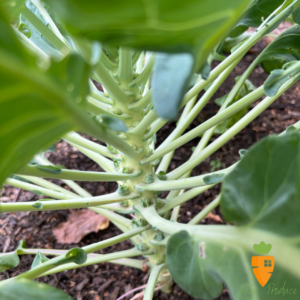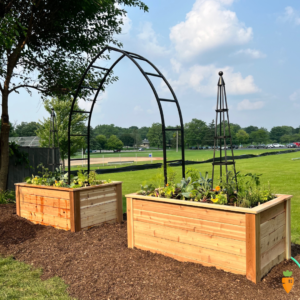If you’re the kind of person who plants your garden on one day in May and doesn’t plant anything else the rest of the year, this post is for you.
First, you get major points for planting a garden. I know that life gets in the way and sometimes things we value, like a garden or the fresh food that comes from it, have to fall to the wayside. But you did it!
Now let’s spend a teeny bit more time planning for your garden’s success so you can keep harvesting more and later in the season than you ever have. It all comes down to putting the right plant in the right place at the right time.

So What If I Plant Everything In May?
When you plant your whole garden in May, you limit yourself. You’re putting all your eggs in one basket, hoping that all the veggies you planted will survive and have no backup plan if they don’t. But here’s the thing: your garden can be immensely more productive if you keep popping a few seeds and plants in now and again instead of planting once and letting the garden sit all summer.
If you only planted a garden in May this year, the year we had a really cold spring, your hot season plants might not be doing so well. Tomatoes, peppers and cucumbers can struggle in May if the soil hasn’t warmed up enough. So in April and May, it’s best to plant salad greens and snow peas because they LOVE the random cold spring nights that dip near and below freezing. They’ll keep growing like crazy and will churn out salad leaves and snow peas like you won’t believe. They grow best in cold, so plant them a lot in spring and fall.
Cucumbers, tomatoes, and peppers will hate those cold conditions. Exposing them to enough cold nights or one night close to freezing will kill them or at least stunt their growth for the rest of the season. You certainly won’t get a great harvest from them.
But they love the heat! When temps get into the 80s, tomatoes thrive. And when it hits the 90s and above, cucumbers and peppers are happy as clams. So your garden harvests will be more productive if you plant these veggies a little later in the season when the weather is warmer.
The goal is to make sure each veggie plant has optimal growing conditions so it can provide you with the biggest harvest possible.

Alright, Alright. So What Do I Plant Now?
In July, the Chicago area transitions from the “warm” season where salad greens thrive into the “hot” season, where cucumbers and tomatoes reign. What you plant should transition with it.
This month, I’m planting my final row of bush beans, sunflowers and baby pumpkins for the fall, cucamelons (which is just fun to say), cucumbers, and my fall cabbages, cauliflower, and broccoli.
I’m also continuing to plant heat-tolerant spinach and lettuce so we can have garden-fresh salads as often as we’d like. Since they’ll be stressed by the heat, I’ll plan on harvesting the leaves while they’re smaller and replacing the plants more often as they bolt. If you want to be the best hot-season salad gardener you can be, I’ve included some helpful tips here.
I’m also planning on taking a vacation at the end of the month, so the garden will be on pause for two weeks. If you’re planning a vacation too, I’ve created a short list of garden maintenance you need to do before you leave to make sure your garden thrives while you’re gone and you can pick up where you left off when you return.
Most importantly, keep planting! Don’t let any space in your garden be wasted the rest of the growing season. By continuing to plant, you can keep your garden as green in September and October as it was in May.








